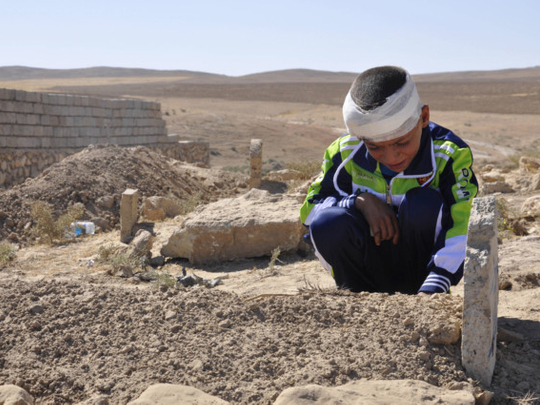
BAaghdad: First came the fireball, then the screams of the victims. The suicide bombing just outside a Baghdad graveyard knocked Nasser Waleed Ali over and peppered his back with shrapnel. Ali was one of the lucky ones.
At least 51 died in the October 5 attack, many of them Shiite pilgrims walking by on their way to a shrine. No one has claimed responsibility, but there is little doubt Al Qaida’s local franchise is to blame. Suicide bombers and car bombs are its calling cards, Shiite civilians among its favourite targets.
Al Qaida has come roaring back in Iraq since US troops left in late 2011 and now looks stronger than it has in years. The terror group has shown it is capable of carrying out mass-casualty attacks several times a month, driving the death toll in Iraq to the highest level in half a decade. It sees each attack as a way to cultivate an atmosphere of chaos that weakens the Shiite-led government’s authority.
Recent prison breaks have bolstered Al Qaida’s ranks, while feelings of Sunni marginalisation and the chaos caused by the civil war in neighbouring Syria are fueling its comeback.
“Nobody is able to control this situation,” said Ali, who watches over a Sunni graveyard that sprang up next to the hallowed Abu Hanifa mosque in 2006, when sectarian fighting threated to engulf Iraq in all-out civil war.
“We are not safe in the coffee shops or mosques, not even in soccer fields,” he continued, rattling off some of the targets hit repeatedly in recent months.
The pace of the killing accelerated significantly following a deadly crackdown by security forces on a camp for Sunni protesters in the northern town of Hawija in April. United Nations figures show 712 people died violently in Iraq that month, at the time the most since 2008. The monthly death toll hasn’t been that low since. September saw 979 killed.
Al Qaida does not have a monopoly on violence in Iraq, a country where most households have at least one assault rifle tucked away. Other Sunni militants, including the Army of the Men of the Naqshabandi Order, which has ties to members of Saddam Hussain’s now-outlawed Baath party, also carry out attacks, as do Shiite militias that are remobilising as the violence escalates.
But Al Qaida’s indiscriminate waves of car bombs and suicide attacks, often in civilian areas, account for the bulk of the bloodshed. The group earlier this year renamed itself the Islamic State of Iraq and the Levant, highlighting its cross-border ambitions. It is playing a more active military role alongside other predominantly Sunni rebels in the fight to topple Syrian President Bashar Assad, and its members have carried out attacks against Syrians near the porous border inside Iraq.
The United States believes the group’s leader, Abu Bakr Al Baghdadi, is now operating from Syria. “Given the security vacuum, it makes sense for him to do that,” said Paul Floyd, a military analyst at global intelligence company Stratfor who served several US Army tours in Iraq. He said the unrest in Syria could be making it even easier for Al Qaida to get its hands on explosives for use in Iraq.
“We know Syrian military stocks have fallen into the hands of rebels. There’s nothing to preclude some of that stuff flowing across the border,” he said.
Iraqi officials acknowledge the group is growing stronger. Al Qaida has begun actively recruiting more young Iraqi men to take part in suicide missions after years of relying primarily on foreign volunteers, according to two intelligence officials. They said Al Baghdadi has issued orders calling for 50 attacks per week, which if achieved would mark a significant escalation. One of the officials estimated that Al Qaida now has at least 3,000 trained fighters in Iraq alone, including some 100 volunteers awaiting orders to carry out suicide missions. Both officials spoke on condition of anonymity because they are not authorised to disclose intelligence information.
. American troops and Iraqi forces, including Sunni militiamen opposed to the group’s extremist ideology, beat back Al Qaida after the US launched its surge strategy in 2007. That policy shift deployed additional American troops to Iraq and shifted the focus of the war effort toward enhancing security for Iraqis and winning their trust.
By 2009, Al Qaida and other Sunni extremist groups were “reduced to a few small cells struggling to survive and unable to mount more than token attacks,” Kenneth Pollack, a Clinton administration official who is now a Middle East analyst at the Brookings Institution, noted in a report earlier this year.
Now there are fears that all the hard work is coming undone. Iraqis, both Sunni and Shiite, say they are losing faith in the government’s ability to keep the country safe. “Al Qaida can blow up whatever number of car bombs they want whenever they choose,” said Ali Nasser, a Shiite government employee from Baghdad.
“It seems like Al Qaida is running the country, not the government in Baghdad.” Many Sunnis, meanwhile, are unwilling to trust a government they feel has sidelined and neglected their sect. Iraqi officials say that lack of trust has hampered intelligence-gathering efforts, with fewer Sunnis willing to pass along tips about suspected terrorist activities in their midst.
“During the surge, we helped build up the immune system of Iraq to deter these attacks. Now that immune system has been taken away,” said Emma Sky, a key civilian policy adviser for US Army General Ray Odierno when he was the top American military commander in Iraq.
“Before you had the US there to protect the political space and help move the country forward,” she added. “How much longer can this go on before something breaks?”











